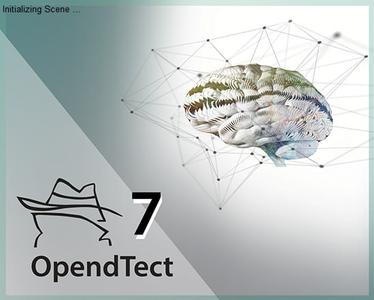V
voska89
Moderator
- Joined
- Jul 7, 2023
- Messages
- 42,387
- Reaction score
- 0
- Points
- 36

Free Download dGB Earth Sciences OpendTect 7.0.2 (x64) | 6.1 GB
OpendTect is a free, open-source seismic interpretation system for visualizing, analyzing and interpreting 2D, 3D and 4D seismic data. It is also widely used for Geo-Radar interpretation. OpendTect is released under the GNU Public License (GPLv3 or higher). OpendTect is also a software development environment for fast-track development of new plugins (in C++). Third-party developers can choose to develop under the GPL license. If so, derived products must be released as open-source plugins (copy-left principle). Alternatively, developers can opt to develop under the OpendTect Pro license agreement, which permits development of closed source plugins. Code developed in Matlab and Python can be integrated into OpendTect. For more information, please visit the software development page.
"dGB's business model promotes sharing ideas and advancing technology together."
-Jean-Francois Dutzer, Geophysics R&D Manager, GdF-Suez
"OpendTect was one of the keys of success of our IBA teams who could secure second place in the regional competition for this year 2020 and the first place for the past three years."
-Mohammed Farfour, PhD Earth Science Department, Sultan Qaboos University
Interpretation
OpendTect supports all tools you expect to find in a seismic interpretation system, including but not limited to:
-2D, 3D and Pre-stack seismic viewers, cross-Descriptions, log viewers
-Horizon trackers (auto-tracking, manual, gridding, ...)
-Fault interpretation (sticks and planes)
-Well-tie module
-Time-Depth Conversion
-3D bodies
-Mapping (via GMT)
Attributes
-OpendTect started life as a seismic pattern recognition and attribute processing system. It supports the industry's most advanced seismic attribute engine including:
-Extensive set of industry-standard attributes and filters and many unique OpendTect ones
Pre-stack attributes
-Ability to create attributes-from-attributes using math and logic
-Interactive evaluation of attributes and movie-style inspection of attribute parameters on any seismic display element
-Multi-machine, multi-platform, distributed batch processing
Note: more atributes are available in various commercial plugins such as Dip-Steering, Faults & Fractures, FracTex, Colored Inversion, Spectral Bluing,
Data IO
-OpendTect supports import and export of data in industry-standard formats such as SEG-Y (2D, 3D and Pre-stack Seismic), LAS (logs), ASCII (seismic, navigation data, faults, fault sticks, horizons, well data, pointsets / polygons, survey settings, velocity functions, mute functions, cross-Description data, probability density functions, and color tables), DTZ (GPR), Geotiff and Geopackage (GIS applications via free WMplugins).
-Note 1: most objects listed above can be imported as well as exported, some can only be imported, others only exported.
Free Gems
-OpendTect supports lots of functionalities for free that are highly priced in other software systems. To name a few:
-Spectral Decomposition. Data can be decomposed and RGB(A) blended on horizons, sections and volumes. OpendTect supports decomposition by: Short window FFT, Continuous Wavelets, Empirical Mode Decomposition (EMD), Ensemble EMD, Complete Ensemble EMD, Local Attribute and Recursive Filter.
-Rock physics library. An extensive rock physics library supports many industry standard rock-physics equations to compute well logs from existing logs.
-Pre-stack viewers. Pre-stack gathers can be pre-processed (mutes, super-gathers, scaling, ...) and displayed in the 3D scene along seismic sections. Alternatively, gathers can be displayed in flat viewers.
-Distributed computing. OpendTect can process data in batch mode on clusters and on multiple machines on multiple platforms.
-Special Attributes. Fingerprint attribute computes the match between the attribute response at known - and unknown locations; Match Delta and Delta Resample attributes, respectively compute and apply, dynamic time-shifts to correct mismatches between angle stacks and 4D stacks; Position, Reference and Mathematics attributes chained together enable construction of powerful filters and attributes.
-Presentation Maker.This Python utility is a huge time saver for presenting your work. It automatically creates PowerPoint presentations from grabbed OpendTect images.
System Requirements:
OS:10/11, older Windows versions may work, but are no longer tested.
CPU:Intel/AMD, 64 bits
GPU:Basic Intel graphics cards or Nvidia (e.g. recent GeForce/Quadro/NVS series) graphics cards; AMD graphics cards may work.
Memory
Storage:SSD is best, other good options are Hard Disk and Network Drive.
This is usually under-valued, but it's often the crucial performance component. SSD disks will give a tremendous boost in performance; essentially, data on SSD disks loads almost as fast as pre-loaded, in-memory data. Performance could be miserable if data needed to stream through (relatively) slow disks and/or networks.
Home Page -
Code:
https://www.dgbes.com/Recommend Download Link Hight Speed | Please Say Thanks Keep Topic Live
Rapidgator
0kwzl.dGB.Earth.Sciences.OpendTect.7.0.2.x64.rar.html
Uploadgig
0kwzl.dGB.Earth.Sciences.OpendTect.7.0.2.x64.rar
NitroFlare
0kwzl.dGB.Earth.Sciences.OpendTect.7.0.2.x64.rar
Links are Interchangeable - No Password - Single Extraction
